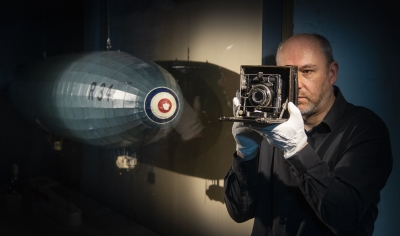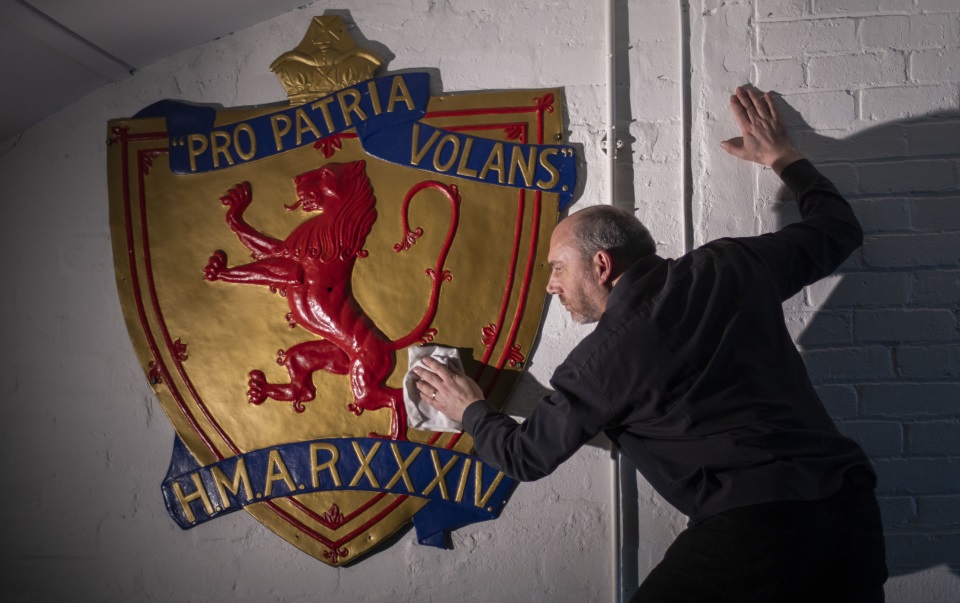THE TRANSATLANTIC MAGAZINE
THE TRANSATLANTIC MAGAZINE

Sign up to The American magazine's newsletters (below) to receive more regular news, articles and updates on America in the UK.
The First East to West Transatlantic Flight
2019 marks 100 years since the flight of the R34 Airship
By Louise Innes, Principal Transport Project Curator at the National Museum of Flight
At 1.42 am on Wednesday July 2, 1919, a bugle sounded the “Let Go” signal at Royal Naval Air Station East Fortune, East Lothian, Scotland and the 700 ground crew released the huge R34 airship to let it rise slowly into the night sky on the first stage of a record-breaking, 6,000-mile double crossing of the Atlantic.
Constructed at Inchinnan near Glasgow, His Majesty’s Airship R34 was a massive 634 ft long and inevitably nicknamed ‘Tiny’. The gas bags alone required the intestines of 600,000 oxen to make them. She had arrived at East Fortune too late to join wartime convoy protection and anti-submarine activities and only made one operational voyage over the Baltic Sea as a show of strength in advance of the ratification of the Treaty of Versailles.
According to Brigadier General E M Maitland’s fascinating log of the journey, the transatlantic flight had a number of objectives. It aimed to gather information about flying and meteorological conditions in the Atlantic during an extended flight and would investigate whether large rigid airships of this kind could be the future of long-distance travel. By landing in the USA, Britain would also forge new links between the two countries.
The R34’s voyage took place just a few weeks after Alcock and Brown’s record-breaking west-east Atlantic flight in a converted WWI bomber aircraft. As well as undertaking the first east-west crossing of the Atlantic, the R34 would complete the first return journey. Other records were broken during the flight, with Major Pritchard becoming the first person to arrive in the USA by air when he parachuted from the airship to take charge of the hundreds of ground crew required. Also on board this pioneering flight were the world’s first human and feline transatlantic aerial stowaways, William Ballantyne and Wopsie the cat.
Ballantyne, an aircraftsman, had been left out of the 30-strong crew to make room for an American observer as weight was critical. Unwilling to miss out, he hid on top of a girder between the airship’s gas bags. He was discovered, having become overcome by leaking hydrogen from the airship’s gas bags and after recovering, was put to work pumping petrol and cooking.
The R34 reached Mineola, Long Island at 9.45am on July 6, 1919, 108 hours and 12 minutes after it departed East Fortune, following an adventure-filled journey that was hampered by dwindling fuel supplies, violent squalls and a leak that was repaired with the crew’s entire supply of chewing gum.

It’s a wonderful story that’s told as part of the National Museum of Flight’s Fortunes of War permanent display at East Fortune. The displays give a fascinating insight into the technologies and social history of the time and feature objects including the R34’s large bow-plate with its Scottish lion rampant, the altimeter dial, a small piece of the distinctive blue fabric that covered the framework as well as a bottle of brandy carried on board for medicinal reasons. There’s also a memorial to the flight, a twin of which exists in Mineola.
The crew was the toast of the town on arrival in the USA and was wined and dined in New York and showered with gifts including a rare case of prohibited rum. The R34 then flew over the skyscrapers of New York as it set off for home, landing at Pulham in England 75 hours later after inadvertently soaking the welcoming musicians with water ballast.
Sadly, the R34 was scrapped in 1921 following an accident in high winds but her transatlantic journey remains one of Scotland’s most fascinating aerial adventures.
To mark the centenary, the National Museum of Flight has launched a search for images and memorabilia plus recollections from descendants of the R.34’s crew members which we hope to develop into a digital gallery to help tell the airship’s story. Anyone wishing to share stories or images should email info@nms.ac.uk,info@nms.ac.uk, call +44 (0)131 247 4238 or post to National Museum of Flight, East Fortune Airfield, East Lothian, EH39 5LF. To find out more details on the Museum's exhibitions, check out www.nms.ac.uk/flight
